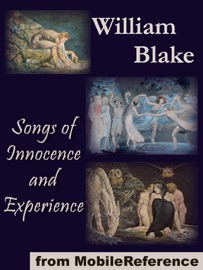
Songs of Innocence and of Experience: Shewing the Two Contrary States of the Human Soul are two books of poetry by the English poet and painter, William Blake. Although Songs of Innocence was first published by itself in 1789, it is believed that Songs of Experience has always been published in conjunction with Innocence since its completion in 1794.
Songs of Innocence mainly consists of poems describing the innocence and joy of the natural world, advocating free love and a closer relationship with God, and most famously including Blake's poem The Lamb. Its poems have a generally light, upbeat and pastoral feel and are typically written from the perspective of children or written about them.
— Excerpted from Wikipedia, the free encyclopedia.
Table of Contents:
Songs of Innocence
Introduction
The Shepherd
The Echoing Green
The Lamb
The Little Black Boy
The Blossom
The Chimney-sweeper
The Little Boy Lost
The Little Boy Found
Laughing Song
A Cradle Song
The Divine Image
Holy Thursday
Night
Spring
Nurse's Song
Infant Joy
A Dream
On Another's Sorrow
Songs of Experience
Introduction
Earth's Answer
The Clod And The Pebble
Holy Thursday
The Little Girl Lost
The Little Girl Found
The Chimney-sweeper
Nurse's Song
The Sick Rose
The Fly
The Angel
The Tiger
My Pretty Rose Tree
Ah, Sunflower
The Lily
The Garden Of Love
The Little Vagabond
London
The Human abstract
Infant Sorrow
A Poison tree
A Little Boy Lost
A Little Girl Lost
A Divine Image
A Cradle song
The Schoolboy
To Tirzah
The Voice of The Ancient Bard